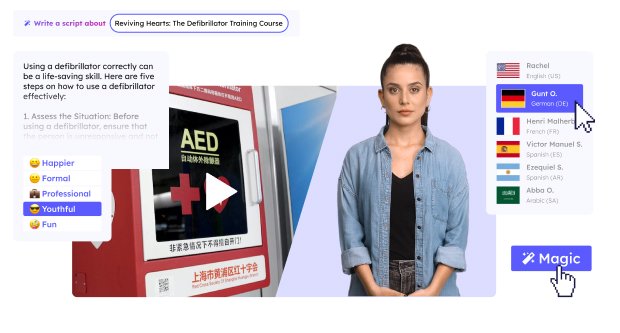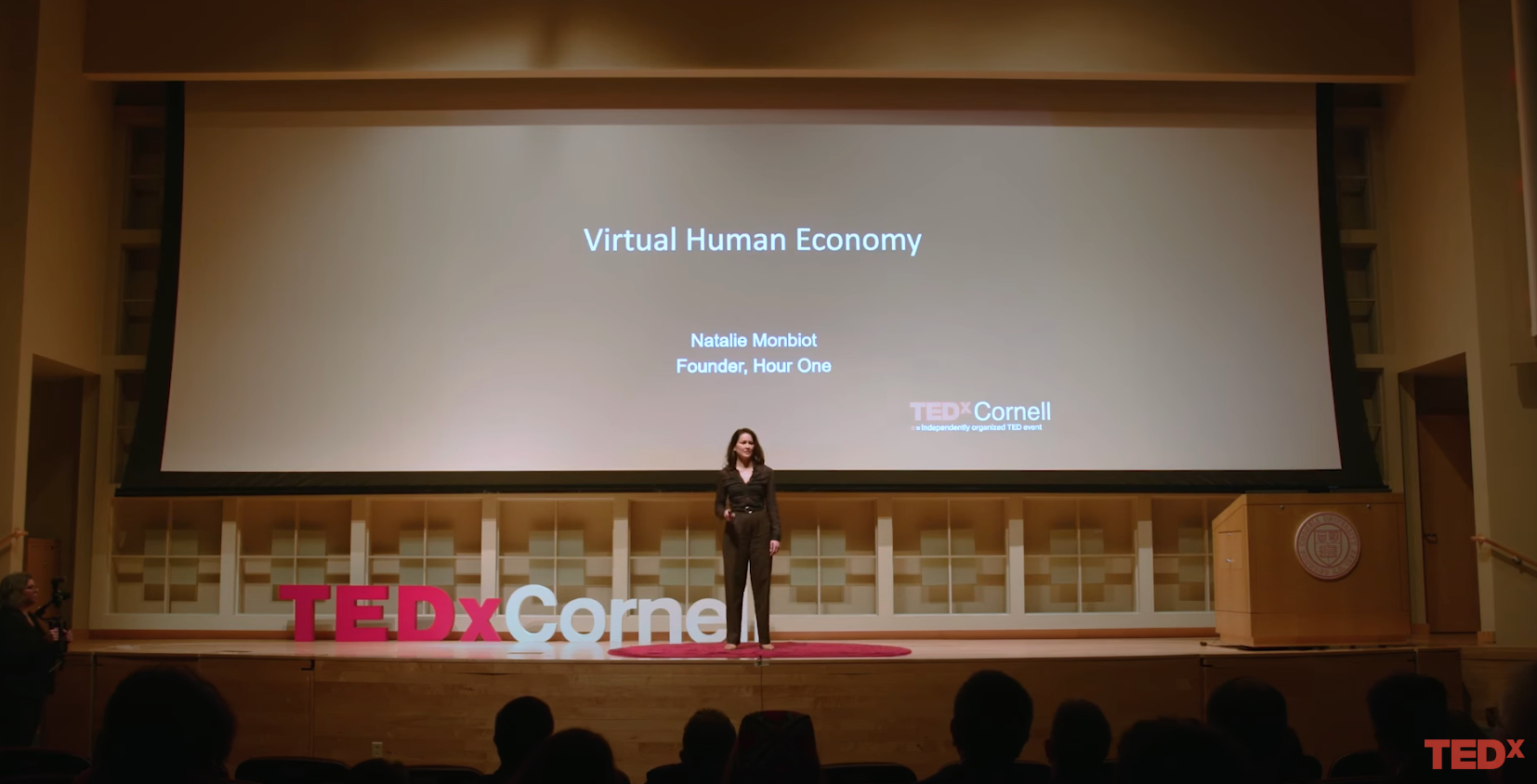In 2024, Learning and development (L&D) is on the brink of a transformative shift. The age-old approach to producing educational videos has forever been a multilayered and often cumbersome process. What kicks off with brainstorming by L&D teams, aimed at setting learning objectives and video goals; from there on, the journey takes a somewhat counterintuitive path. Workflow becomes almost backward and regressive, with editing left to the final stages. This setup hampers a clear vision of the final picture and introduces rigidity in post-production fine-tuning.
Consider this scenario: content often comes into existence only to later be deemed unnecessary, leading to its redundancy. In effect, this results in not just the wastage of precious time and resources for businesses but also undermines the overall efficiency of the creative and production processes. Another complication arises from the essential requirement for thorough planning; without it, production quality becomes compromised, placing an additional burden on the entire process.
Delving deeper, the world of regular video production is a realm of intricate complexity. It calls for synchronized efforts from a diverse team of content creators, scriptwriters, designers, animators, and editors. The demand for this close-knit collaboration isn’t just a challenge in itself but also consumes a substantial amount of time, often involving back-and-forth sessions of editing, refining, and reviewing until the final masterpiece takes shape. It’s a process that demands patience, cooperation, and a meticulous approach to attain the desired outcome.
Today, as generative AI emerges as a dominant force, it’s reshaping the landscape of L&D. By producing professional, immersive, tailor-made learning tools that considerably reduce the expenses and duration of content creation, generative AI is redefining how L&D teams can create educational material. In this article, we will take a look at seven different ways that generative AI can be applied as an unparalleled tool for educational content creation, addressing and rectifying all of the problems mentioned above.

What is generative AI, and how can it help my team?
Simply put and without boring you too much, generative AI is a type of artificial intelligence designed to create new content by mimicking patterns and styles it learns from existing data, such as a prompt. Instead of just analyzing and making decisions, it “generates” or produces new outputs, like text, images, or music, or in this case – videos.
In the four years we have been working on our generative video platform, Hour One, we have learned that a key advantage of generative AI is its ability to streamline collaborative processes for video creation. The greatest challenge for video production is the ability to foster team collaboration, especially when most team members lack familiarity, knowledge, and experience in the other’s field of work. This insight is what led us to specialize our product to streamline video production processes for all team members.
Today, with tools like Hour One, teamwork has been made easy, and we no longer need to overcomplicate video processes. Brainstorming sessions can be done with high efficiency, helping teams converge on solutions and explore directions they were hesitant to consider before. Providing and applying feedback has been made easy. Trial and error isn’t something to be feared. Teams no longer have to be highly skilled in all areas as the platform can step in to provide insights or generate content where there might be a skills gap. Complex data can be presented in easily understood visuals or explained with clarity.
By creating a tool that is capable of generating a video of professional-grade quality from just a few simple prompts, we are not only helping businesses to cut costs and save time, but we are also aiding the team process in creating effective and scalable educational content, maximizing the team effort rather than relying on individual contributions.
What is the demand for L&D video content?
Creating educational material is not an easy task in itself. There are many challenges that need to be confronted, such as the diverse needs of students, the ability to present complex ideas in a way that will be understood, the need for material that can be easily scaled, distributed, and used across different platforms and regions without losing effectiveness, and many other considerations.
In the dynamic and ever-evolving modern world, the demand for learning and development video content is soaring, driven by increasing recognition of the power and convenience of visual and interactive mediums in acquiring new skills and knowledge. From bustling corporate environments where innovative training videos empower employees to develop skills in communication, leadership, and cutting-edge technologies, to vibrant online educational platforms offering engaging video-based courses spanning coding, data analysis, creative arts, and languages – the potential for video learning knows no limits. Even the healthcare industry is embracing this trend, as medical professionals enthusiastically adopt instructional videos for mastering complex procedures and techniques. Beyond the professional sphere, individuals seeking personal growth and self-improvement are diving into captivating videos offering insights into mindfulness, time management, personal finance, and more.
By bringing learning to life through simulations, case studies, and interactive scenarios, L&D videos are turning people’s heads and are now recognized as a very valuable tool. As technology continues to expand, generative AI for L&D has the power to reshape how we learn, catering to diverse learning preferences and needs with zest and zeal.
7 ways generative AI can create effective educational content
In this section, we will look at seven major ways in which generative AI can reshape and enhance the learning experience, so here we go:
1. Allows easy video creation
Have you ever wondered how easy it could be to explain a complex idea if it could be visualized? Did you know that the brain processes video content 60,000 times faster than text? It is understood and proven through countless studies that video is not only people’s preferred learning format but is also the most captivating. It is the mix of images, sounds, movement, and effects that keep us so engaged. As our attention spans are getting shorter, video has the power to capture our attention and hold it as no other media can.
But that’s not all. Video allows students to learn at their own place, catering to various learning preferences. Students not only want to control the information they are taking in, but they want to control the amount and when it suits them. Video makes learning flexible and self-paced, providing a necessary solution for many, reducing cognitive overload, and enhancing comprehension.
By making content available on digital platforms and in video format, education, and training materials are much more accessible. Educational material can reach a much broader audience by adding subtitles, slow down features, and using assistive technologies.
Yes, video is great for the end user, but the contribution to learning institutions or businesses is no less impressive. Generative AI makes video production scalable. With AI, traditional tedious and expensive video production processes are streamlined and transformed into inexpensive, consistent, and engaging videos – all of this while not compromising on its quality.
FYI, with tools like Hour One, video production is no more difficult to do than creating a PowerPoint presentation.
If we haven’t convinced you by now, we have six other reasons ahead.
2. Enables consistent L&D collaboration
At the heart of all practical training material is successful team collaboration. That said, the traditional video creation approach throws a wrench into the gears of collaboration. Once the camera stops rolling, the door to include input from colleagues slams shut. The inability to tweak text or insert a scene based on a spur-of-the-moment idea hampers the creative process. The perks of generative AI go beyond last-minute edits – it redefines collaboration. Videos can be edited on the fly, amplifying the collective creative prowess. And that’s just the tip of the iceberg.
Sharing videos with peers becomes a breeze. Not only can you edit the video at any time, but you can tag them onto specific scenes and gather their insights right within the workspace as you go. By streamlining teamwork, AI-driven video content has the power to reshape the very essence of content creation.
Imagine this. You’ve spent days on end working on a video production for a client you know can be hard to please. You’ve just received feedback from this client, and he tells you that some of the information in the video is incorrect. With traditional video production, you must rewrite the script, deal with the editor, rehire actors and the film crew, and do it all again. With generative AI, you can make adjustments in minutes and with zero fuss.
3. Revolutionizes content translation and localization
Generative AI allows organizations to tailor all content to any kind of audience. With platforms such as Hour One, you can translate and recreate content in ways that will resonate with your selected target demographic. Thanks to the text-to-speech functionality, the need for hiring actors or investing in translators for script translations or subtitles becomes obsolete. This AI-driven innovation effortlessly takes on these tasks, resulting in significant time and cost savings. Moreover, the potential extends beyond video translation. Through the choice of a virtual presenter aligned with your target audience’s ethnicity, businesses can refine their image, attire, and persona to achieve localization.

4. Seamless integrations with LMS systems
Embedding your video into an LMS system is as simple as using an embed code. This integration facilitates dynamic content modifications, tailors content according to learner profiles, and offers insights through real-time analytics. By doing so, you’re not just enhancing the accessibility of your educational material but also guaranteeing a uniform yet personalized learning experience tailored to individual learner requirements.
5. You can select the perfect presenter for your video
So, we’ve already established that video is the most engaging form of educational material, but what’s the secret to unlocking its full potential? That answer is talking heads. Studies show that AI avatars rival conventional videos in delivering a rich learning experience. With an AI avatar as your virtual presenter, you can directly address the audience. From a scientific point of view, the human brain is naturally wired to pay more attention to faces and human-like interactions, making them a lot more engaged and invested in your content, facilitating better comprehension. Through nuances such as facial expressions, gestures, and vocal intonations, your AI avatar can complex ideas and emphasize crucial points much more vividly than text or graphics alone. This adds an emotional dimension, making the educational content more relatable and memorable.
By using AI avatars, your presenter is not only timeless (no risk they will be leaving the organization), but you will also be saving yourself some serious money. Platforms like Hour One make the creation process straightforward, boasting a roster of over 100 lifelike AI presenters and supporting more than 80 languages, all achievable with a few simple clicks. With various iconic characters to choose from, imagine having Barack Obama explain your organizational guidelines.
6. Enhance video efficacy with interactive elements
Interactive elements can be a big, game-changing strategy for your video content. Interactive components, such as clickable links, embedded quizzes, drag-and-drop exercises, and user-directed scenarios, transform passive viewing into an active learning experience. By demanding direct engagement from the viewer, these elements reinforce key concepts, enhance retention, and provide immediate feedback on understanding.
By giving users control over Pause, Stop, and Repeat functions, you are tailoring the learning experience to individual paces and preferences, allowing learners to revisit challenging segments or skip ahead as needed. This personalized approach not only enhances comprehension but also gives the student a sense of agency and involvement in his learning journey.
7. Maintains consistency across all platforms
Ensuring consistency in creating educational content can be challenging, given the multiple teams involved. Generative AI, however, offers a solution by ensuring videos align seamlessly with an organization’s branding by using templates. These video templates provide standardized elements like fonts, styles, colors, and transitions. Platforms like Hour One amplify this feature, allowing users to design customized video templates from scratch and store them for future productions.
Generative AI with Hour One

Regardless of how much you use AI to craft educational material, its potential cannot be overstated. Hour One stands as a testament to the power of AI in shaping L&D video content. With a heavy focus on streamlining and maintaining consistency, our advanced AI-driven tools generate captivating and compelling educational videos. The rapidly evolving landscape of AI might make future applications in L&D hard to pinpoint, but its implications extend well beyond. At HourOne, our commitment to L&D is just the tip of the iceberg. We envision reshaping sectors like marketing, eCommerce, corporate, and education by empowering content creators with generative AI’s capabilities.
Thank you for reading this article; I trust you found it insightful! While we’ve highlighted a few advantages of generative AI in educational video content, the list goes on forever. To truly grasp generative AI’s essence, I recommend you explore Hour One with our complimentary trial, offering firsthand experience of AI video’s magic. Should you have any questions or if you’d just like to share feedback, our team would be glad to hear from you. Enjoy!







